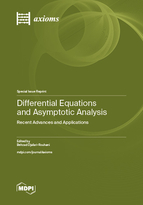Differential Equations and Asymptotic Analysis: Recent Advances and Applications
A special issue of Axioms (ISSN 2075-1680). This special issue belongs to the section "Mathematical Analysis".
Deadline for manuscript submissions: closed (31 December 2023) | Viewed by 15755
Special Issue Editor
Interests: nonlinear evolution equations; nonlinear difference equations; fixed point theory; variational inequalities; optimization
Special Issue Information
Dear Colleagues,
Many real-world problems in science and engineering, including physical, biological, social phenomena, etc., can be mathematically formulated and rigorously solved by modeling them in terms of linear and nonlinear differential and partial differential equations. The aim of this Special Issue titled “Differential Equations and Asymptotic Analysis: Recent Advances and Applications” is to provide a forum for researchers working in this field to submit and publish their related recent works, both of a theoretical and an applied nature. A major emphasis is placed on the investigation of the asymptotic behavior of solutions and the existence of periodic solutions to these equations or systems of equations, as well as the approximation of the solutions. This is of course rather broad, and includes major parts of linear and nonlinear differential and partial differential equations, difference equations, ergodic theory, the calculus of variations, convex and nonconvex optimization, and much more.
Prof. Dr. Behzad Djafari-Rouhani
Guest Editor
Manuscript Submission Information
Manuscripts should be submitted online at www.mdpi.com by registering and logging in to this website. Once you are registered, click here to go to the submission form. Manuscripts can be submitted until the deadline. All submissions that pass pre-check are peer-reviewed. Accepted papers will be published continuously in the journal (as soon as accepted) and will be listed together on the special issue website. Research articles, review articles as well as short communications are invited. For planned papers, a title and short abstract (about 100 words) can be sent to the Editorial Office for announcement on this website.
Submitted manuscripts should not have been published previously, nor be under consideration for publication elsewhere (except conference proceedings papers). All manuscripts are thoroughly refereed through a single-blind peer-review process. A guide for authors and other relevant information for submission of manuscripts is available on the Instructions for Authors page. Axioms is an international peer-reviewed open access monthly journal published by MDPI.
Please visit the Instructions for Authors page before submitting a manuscript. The Article Processing Charge (APC) for publication in this open access journal is 2400 CHF (Swiss Francs). Submitted papers should be well formatted and use good English. Authors may use MDPI's English editing service prior to publication or during author revisions.
Keywords
- linear and nonlinear differential equations
- linear and nonlinear evolution equations
- monotone and accretive operators
- linear and nonlinear semigroups of operators
- periodic solutions
- ergodic theorems
- resolvents
- fixed points
- subdifferential mappings
- asymptotic behavior





